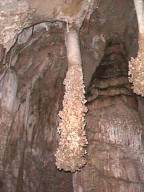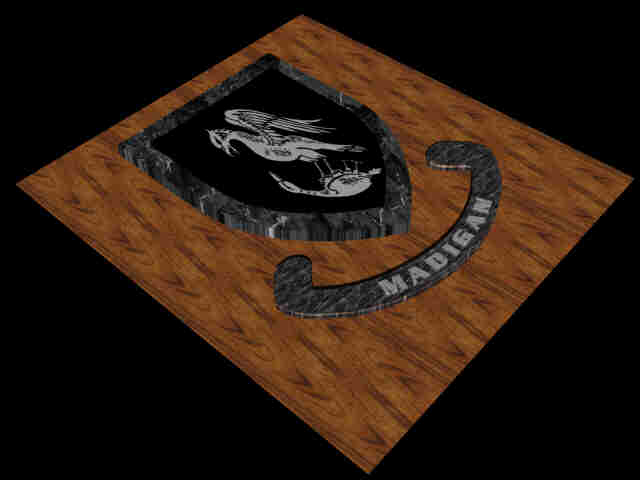The walk down was a steep
switchback  asphalt walkway with guard rails. Every so often
placards described our surroundings. As we passed the dark
passage which led to the Bat Cave, we were joined by Ranger Chuch
Oliver who explained that this is the summer home of thousands of
Mexican freetail bats. The bats roost here from March to October
During the day bats hang by their feet from the ceiling in great
clusters. At sunset they stream out past this point to hunt
flying insects. The actual roosting area is closed to the public.
Guano (bat manure) has accumulated on the floor of Bat Cave to
depths of more then 40 feet. Large quantities of guano create a
toxin requiring those near it to wear breathing apparatus. Near
the bottom we began to see formations along the way. Stalactites,
stalagmites and other cave
asphalt walkway with guard rails. Every so often
placards described our surroundings. As we passed the dark
passage which led to the Bat Cave, we were joined by Ranger Chuch
Oliver who explained that this is the summer home of thousands of
Mexican freetail bats. The bats roost here from March to October
During the day bats hang by their feet from the ceiling in great
clusters. At sunset they stream out past this point to hunt
flying insects. The actual roosting area is closed to the public.
Guano (bat manure) has accumulated on the floor of Bat Cave to
depths of more then 40 feet. Large quantities of guano create a
toxin requiring those near it to wear breathing apparatus. Near
the bottom we began to see formations along the way. Stalactites,
stalagmites and other cave  deposits made chiefly of calcite are called
"decorations" or "Speleothems". Speleothems
are formed when groundwater containing calcium bicarbonate
solutions seeps into the cave. When the solution becomes exposed
to cave air, carbon dioxide gas is released, leaving calcite as a
deposit. The beginning of these deposits are called "Soda
Straws" which are thin hollow stalactites formed by the
dripping water. In time they may become stalactites or
stalagmites. On the limestone walls, we could see a series of
vertical cracks called "joins".
deposits made chiefly of calcite are called
"decorations" or "Speleothems". Speleothems
are formed when groundwater containing calcium bicarbonate
solutions seeps into the cave. When the solution becomes exposed
to cave air, carbon dioxide gas is released, leaving calcite as a
deposit. The beginning of these deposits are called "Soda
Straws" which are thin hollow stalactites formed by the
dripping water. In time they may become stalactites or
stalagmites. On the limestone walls, we could see a series of
vertical cracks called "joins".  The unusual size of the cavern was explained on
a placard which described how a weak carbonic acid, permeated the
joints and dissolved portions of the limestone into small
cavities along the joints. This chemical process is called
"solutioning". Hydrogen sulfide gas bubbled up from
deep oil and gas deposits. Combining with water it formed
corrosive sulfuric acid which further dissolves the limestone
cavities to form large passages. At the bottom, the main
attraction is a walk around in the "Big Room", a
distance of about a mile
The unusual size of the cavern was explained on
a placard which described how a weak carbonic acid, permeated the
joints and dissolved portions of the limestone into small
cavities along the joints. This chemical process is called
"solutioning". Hydrogen sulfide gas bubbled up from
deep oil and gas deposits. Combining with water it formed
corrosive sulfuric acid which further dissolves the limestone
cavities to form large passages. At the bottom, the main
attraction is a walk around in the "Big Room", a
distance of about a mile  and a half. It is here that we found the giant
structures in the section called the "Hall of Giants"
which bore such names as "Rock of Ages", "Giant
Dome", "Temple of the Sun" and "Top of the
Cross". The lighting is not brilliant, being somewhat
subdued to accent the delicate colors caused by iron and other
mineral deposits present in the water. Even so it takes thousands
of lights, strung along hidden wires to create the effect
desired. There is an emergency generator as a power backup and
the cave is generously covered with emergency battery operated
lights should all else fail, still, taking a flashlight with you
is recommended. All in all this was a once in a lifetime
adventure which was worth all the time and effort, and what a
time it was.
and a half. It is here that we found the giant
structures in the section called the "Hall of Giants"
which bore such names as "Rock of Ages", "Giant
Dome", "Temple of the Sun" and "Top of the
Cross". The lighting is not brilliant, being somewhat
subdued to accent the delicate colors caused by iron and other
mineral deposits present in the water. Even so it takes thousands
of lights, strung along hidden wires to create the effect
desired. There is an emergency generator as a power backup and
the cave is generously covered with emergency battery operated
lights should all else fail, still, taking a flashlight with you
is recommended. All in all this was a once in a lifetime
adventure which was worth all the time and effort, and what a
time it was.
***THE END***

